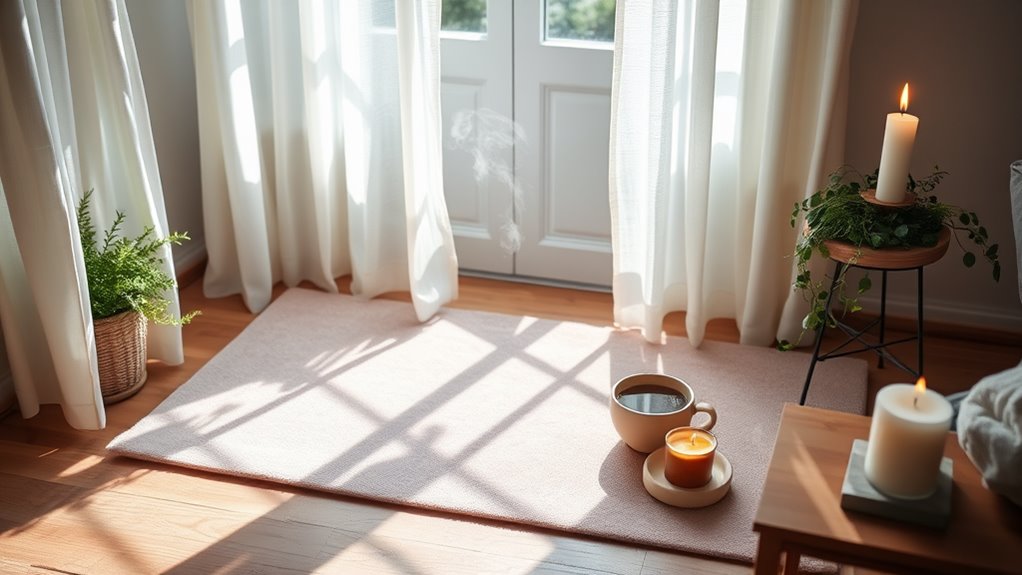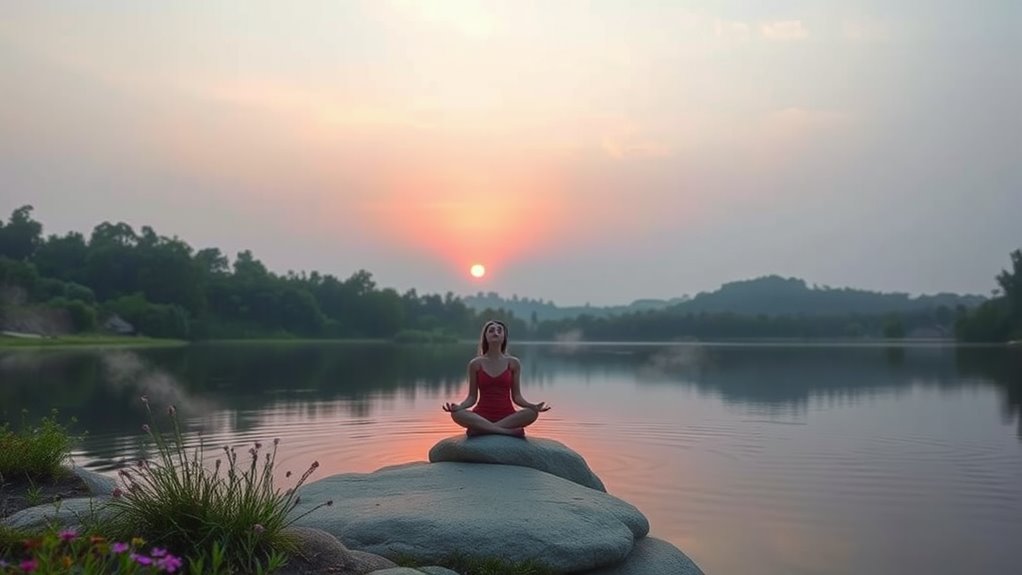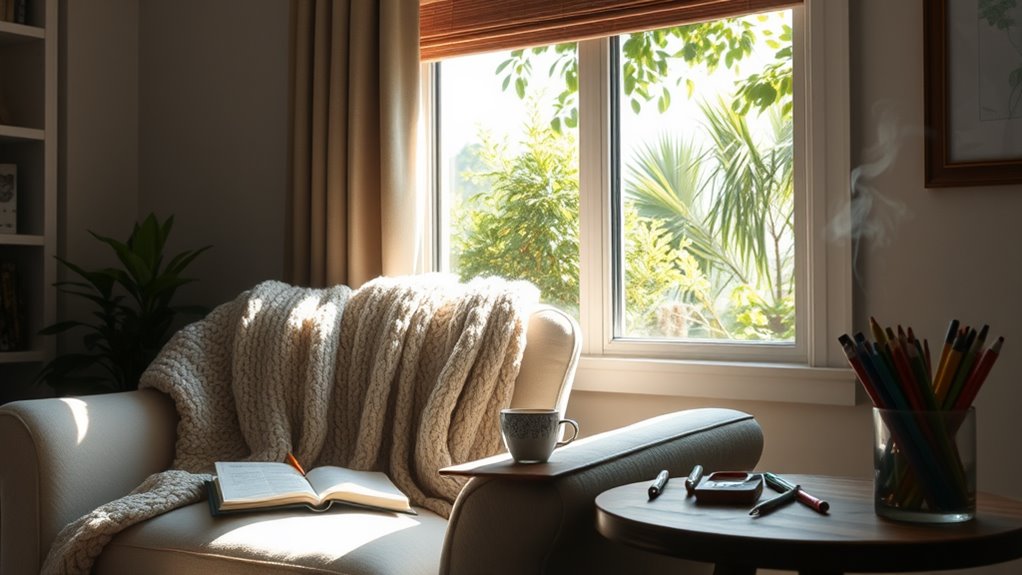Relaxation Techniques for the Busiest Schedules!
You can absolutely find relaxation techniques that fit your busy schedule. Try deep breathing exercises; just a few minutes can bring calm. Mindfulness meditation is a great tool too—focusing on your breath for even a short time can make a difference. Don’t forget quick stretching routines during the day to relieve tension. Nature visualization techniques can transport your mind to a peaceful place, while progressive muscle relaxation helps combat stress. Aromatherapy with calming scents can also enhance your relaxation. By incorporating these practices, you can build a calmer you. And there’s so much more to explore!
Key Takeaways
-
Deep Breathing Exercises: Take a few moments to inhale deeply and exhale slowly to reduce anxiety and regain focus during busy days.
-
Quick Stretching Routines: Incorporate brief office yoga or desk stretches to relieve tension and boost productivity throughout the workday.
-
Digital Detox Moments: Set aside time to disconnect from screens, enhancing mental clarity and promoting mindfulness in your daily routine.
-
Progressive Muscle Relaxation (PMR): Use PMR to release muscle tension by tensing and relaxing different muscle groups, promoting relaxation even in a hectic schedule.
-
Mindfulness Meditation: Dedicate just a few minutes each day to mindfulness meditation, improving overall well-being and fostering a sense of peace amidst chaos.
Deep Breathing Exercises
When life gets hectic, it’s easy to overlook the simple act of breathing. Yet, mastering deep breathing exercises can be a game-changer for your stress management. These breathing techniques aren’t just about filling your lungs; they’re a powerful tool to regain control and calm your mind.
Start by finding a comfortable position, whether seated or standing. Inhale deeply through your nose for a count of four, allowing your abdomen to expand. Hold that breath for a moment, then exhale slowly through your mouth for a count of six. Repeat this cycle several times, and you’ll notice a shift in your body and mind.
Incorporating these exercises into your daily routine, even for just a few minutes, can greatly reduce anxiety and enhance your focus. Think of them as a reset button—an easy way to ground yourself amidst chaos.
With consistent practice, you’ll not only improve your breathing techniques but also cultivate a deeper sense of awareness and resilience. Embrace these moments of stillness and remember: it’s okay to pause and breathe deeply. You’ve got this!
Mindfulness Meditation
Embrace the power of mindfulness meditation to create a sense of calm amidst your busy life. By dedicating just a few minutes each day, you can cultivate a deeper connection with yourself and enhance your overall well-being. Mindfulness meditation encourages breath awareness, helping you anchor your attention and reduce stress.
To make it more relatable, here’s a simple table to guide you in your practice:
| Activity | Focus | Benefits |
|---|---|---|
| Mindful Eating | Savor each bite | Enhances digestion |
| Breath Awareness | Observe your breath | Promotes relaxation |
| Body Scan | Tune into physical sensations | Increases body awareness |
Start by setting aside time for mindful eating; as you enjoy your meals, focus on the flavors and textures. Incorporate breath awareness during your meditation sessions, noticing the rise and fall of each breath. Consistency is key, so aim for daily practice. With these techniques, you’ll not only cultivate a sense of peace but also master the art of being present in your busy life. Remember, it’s all about progress, not perfection. You’ve got this!
Quick Stretching Routines
Finding moments of calm through mindfulness meditation can set the stage for incorporating quick stretching routines into your day. These routines don’t require much time or space, making them perfect for busy schedules. You can easily integrate desk stretches or office yoga into your workday, allowing your body to reset and recharge.
Start with simple stretches that can be done right at your desk. For instance, try seated neck rolls to relieve tension. Raise your arms overhead and stretch side to side to open up your torso. You can even do wrist and finger stretches to combat the strain of typing.
These quick desk stretches can greatly enhance your focus and productivity.
Incorporating brief five-minute sessions of office yoga can also work wonders. Consider a standing forward fold to lengthen your spine or a gentle twist while seated to invigorate your mind.
The beauty of these quick routines is that they not only help relieve physical tension but also promote mental clarity.
Nature Visualization Techniques
When you’re feeling overwhelmed, nature visualization techniques can be a powerful way to find calm.
By imagining serene landscapes and engaging all your senses, you can create a mental escape that rejuvenates your spirit.
Guided nature meditations can also help you harness this tranquility, making it easier to transform your busy day into a more peaceful experience.
Imagining Serene Landscapes
Often, taking a moment to visualize serene landscapes can provide a much-needed escape from the chaos of a busy day. By engaging in landscape meditation, you can cultivate a peaceful mindset, allowing your thoughts to drift away from stress. Picture yourself in a beautiful setting, whether it’s a tranquil beach, a lush forest, or a majestic mountain range. This serene imagery can ground you and bring clarity to your day.
To assist your visualization, here’s a simple table to guide your thoughts:
| Serene Landscape | Key Features | Benefits |
|---|---|---|
| Tranquil Beach | Gentle waves, soft sand | Stress relief, tranquility |
| Lush Forest | Tall trees, chirping birds | Connection to nature, rejuvenation |
| Majestic Mountains | Snow-capped peaks, clear skies | Inspiration, perspective shift |
As you practice imagining these landscapes, let your worries fade. Allow the details to wash over you, creating a vivid escape. Remember, you’re in control of your mental space. Embrace these moments of serenity and watch how they transform your outlook amidst a busy schedule.
Engaging All Senses
Although it may seem challenging to carve out time for relaxation, engaging all your senses during nature visualization can make a profound difference in how you unwind. Picture yourself in a tranquil forest or a serene beach, and take a moment to immerse yourself fully in that environment.
Start with scent exploration; imagine the crisp pine needles or the salty ocean breeze filling your lungs. This connection to nature’s fragrances can ground you, reminding you of the beauty that exists beyond your busy schedule.
Next, focus on sound immersion. Visualize the gentle rustle of leaves or the rhythmic waves lapping at the shore. Let these sounds wash over you, creating a soothing backdrop that helps quiet the noise in your mind.
As you engage your senses, you’ll find that your body responds, tension releases, and your mind clears. It’s a powerful way to anchor yourself amidst life’s chaos.
Guided Nature Meditations
Engaging your senses is just the beginning; guided nature meditations can elevate your relaxation practice even further. By immersing yourself in these techniques, you’ll find a profound sense of calm that can seamlessly integrate into your busy life.
Imagine tuning into nature soundscapes—gentle rustling leaves, birdsong, or the soothing rush of a waterfall. These auditory experiences can transport you, helping you to visualize serene landscapes and tranquil environments.
You don’t need to step outside to reap these benefits. Virtual nature tours can provide a stunning backdrop, allowing your mind to escape and rejuvenate. As you follow a guided meditation, you’ll be led through vivid imagery, engaging your imagination and creating a mental sanctuary.
This practice not only reduces stress but also sharpens your focus, enhancing your overall well-being.
Start small; even a few minutes of guided meditation can yield significant results. As you commit to this technique, you’ll discover an invaluable tool for mastery over your relaxation journey.
Embrace this opportunity to nurture your mind and spirit, and watch as your life transforms into a more balanced, peaceful existence.
Progressive Muscle Relaxation
Many people find themselves feeling tense and overwhelmed amid busy schedules, making relaxation seem like a distant dream. Progressive Muscle Relaxation (PMR) is a powerful technique you can use to combat muscle tension and promote the relaxation response. It’s simple yet effective, allowing you to reclaim your calmness even during the busiest of days.
To start, find a quiet space where you can sit or lie down comfortably. Close your eyes and take a deep breath. Then, focus on one muscle group at a time—beginning with your toes. Tense that muscle for about five seconds, then release and notice the difference. Move through each muscle group, from your feet to your face, intentionally relaxing as you go. This process not only reduces physical tension but also helps clear your mind.
With regular practice, PMR can transform how you handle stress. You’ll cultivate a deeper awareness of your body’s tension, allowing you to address it proactively.
Aromatherapy for Stress Relief
After releasing physical tension with Progressive Muscle Relaxation, you might find that incorporating aromatherapy into your routine can further enhance your sense of calm.
Aromatherapy uses essential oils to create calming aromas that can transform your environment and mindset. By choosing the right scent profiles, you can elevate your relaxation experience.
Here are three therapeutic blends you might consider:
-
Lavender and Chamomile: Known for their soothing properties, these calming aromas can help reduce anxiety and promote sleep.
-
Bergamot and Frankincense: This blend offers a revitalizing yet grounding scent, perfect for lifting your mood while calming your mind.
-
Eucalyptus and Peppermint: Energizing yet relaxing, these oils can help clear your mind and alleviate mental fatigue.
To get started, you can diffuse these essential oils in your workspace or add a few drops to your bath.
Just remember, the goal is to create an environment that nurtures your well-being.
By mastering these aromatherapy techniques, you can cultivate a sanctuary of peace amid your busy schedule.
Embrace these calming aromas, and let them guide you toward deeper relaxation.
Guided Imagery Practices
When life feels overwhelming, guided imagery practices can offer a powerful escape that rejuvenates both your mind and spirit. By harnessing visualization techniques, you can transport yourself to a serene environment, allowing stress to melt away. This practice invites you to engage your senses, vividly imagining sights, sounds, and even scents that promote relaxation.
The guided imagery benefits are manifold. It’s not just about escaping; it’s about enhancing your mental clarity and emotional resilience. As you envision tranquil settings—like a peaceful beach or a quiet forest—you’re training your brain to respond to stress more effectively. This technique helps to lower anxiety levels, foster a sense of control, and promote overall well-being.
To get started, find a quiet space and close your eyes. Picture a place where you feel safe and at ease. Breathe deeply, immersing yourself in the details of your visualization.
With regular practice, you’ll find it easier to access this calming state, even during hectic moments. Embrace guided imagery as a valuable tool on your journey to mastering relaxation, and watch as it transforms your daily life.
Digital Detox Moments
In our hyper-connected world, carving out digital detox moments can be a game-changer for your mental health and well-being. You mightn’t realize it, but constant notifications and endless scrolling can drain your energy and focus.
Taking regular social media breaks and reducing your screen time can help you reclaim your time and clarity. Here’s how to get started:
-
Set Boundaries: Designate specific times during the day when you’ll unplug. Whether it’s during meals or an hour before bed, consistency is key.
-
Engage in Offline Activities****: Find hobbies or activities that don’t involve screens. Reading a book, going for a walk, or practicing a new skill can be incredibly rejuvenating.
-
Practice Mindfulness: Use your digital detox moments to practice mindfulness. Simply sit in silence, breathe deeply, and connect with your surroundings.
This helps ground you and enhances your overall well-being.
Frequently Asked Questions
How Often Should I Practice Relaxation Techniques for Best Results?
Think of a garden; daily practice nurtures growth. To achieve ideal frequency, dedicate at least 10-15 minutes each day to relaxation techniques. Consistency cultivates resilience, enabling you to thrive amidst life’s chaos. You’ve got this!
Can Relaxation Techniques Improve My Productivity and Focus?
Incorporating relaxation techniques can give you a productivity boost and enhance focus improvement. When you take time to recharge, you’ll notice clearer thinking and greater efficiency in your tasks. Master your stress for maximum performance!
Are There Relaxation Techniques Suitable for Children?
You can introduce your child to playful mindfulness through techniques like deep breathing games or simple yoga poses. These child-friendly techniques encourage focus and calmness, helping them master their emotions and enhance their overall well-being.
How Do I Create a Relaxing Environment at Home?
Creating a relaxing environment at home starts with ambient lighting and calming scents. Dim the lights, light some candles or use essential oils. You’ll find these small changes foster tranquility, enhancing your overall well-being.
What if I Have Trouble Concentrating During Mindfulness Practices?
If your mind feels like a chaotic circus during mindfulness, don’t fret! Try concentration strategies like focusing on your breath, or gently redirecting mindfulness distractions. With practice, you’ll find your focus can become a powerful ally.





